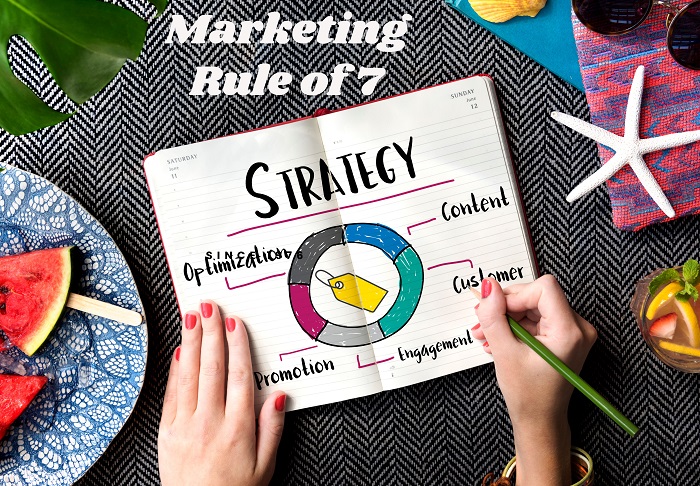In Business-to-Business (B2B) marketing, companies engage with other businesses to sell their products or services. Its dynamics are often more complex and involve longer sales cycles than Business-to-Consumer (B2C) marketing, whose customers are mainly individuals rather than organizations like in B2B.
This complexity arises because B2B transactions typically involve multiple decision-makers, larger investments, and a need for thorough consideration before a purchase is made. As a result, effective marketing strategies in the B2B space must address these unique challenges to succeed.
To solve this issue, one of the traditional strategies in B2B marketing has been the Marketing Rule of 7. However, with the rise of digital channels, the question arises: Is the Marketing Rule of 7 still relevant in today’s digital age? Let’s figure it out here.
Understanding the Marketing Rule of 7
The Marketing Rule of 7 is a time-tested principle in marketing. It originated from traditional media practices such as television, radio, and print advertising, where repeated exposure was necessary due to the limited reach and high cost of each exposure.
It asserts that before potential customers make a purchase decision, they need to see or hear a company’s message at least seven times, hence the name. This repetition helps build familiarity and trust, making it more likely for the prospect to consider the product or service.
For example, whether a business is marketing a complex software solution or a simple loan for $600, the Rule of 7 suggests that potential customers need to see the message multiple times before taking action. The logic is straightforward: the more a potential customer is exposed to a message, the more it stays in their mind, eventually leading them to act.
However, in today’s digital age, the sheer volume of information and the many channels available have significantly changed how marketing messages are delivered and consumed. As mentioned, this evolution raises whether the Rule of 7 still holds true or needs adaptation to fit the new landscape.
Impact of Digital Transformation
Digital transformation has revolutionized B2B marketing. It offers numerous channels and touchpoints to reach potential customers. From social media and email marketing to content marketing and online advertising, businesses now have many options to engage with their audience. This shift has led to increased competition for attention, as potential customers are bombarded with messages from all directions.
The digital landscape has also brought advanced tools and technologies for more precise targeting and personalization. For instance, marketing automation platforms enable businesses to deliver tailored messages based on user behavior and preferences. This personalization can significantly enhance the effectiveness of marketing campaigns, ensuring that the right message reaches the right audience at the right time.
Despite these advancements, the fundamental principle of the Rule of 7 remains relevant. Repetition and consistent messaging are still crucial in building familiarity and trust, even in a digital environment. However, the way these repetitions are achieved has evolved, with a greater emphasis on multi-channel strategies and personalized content.
Challenges in Modern B2B Marketing
The first challenge is the sheer volume of information potential customers encounter daily. With numerous brands vying for attention, it can be difficult for a single message to stand out and be remembered. Additionally, B2B transactions often involve multiple stakeholders, each with their own concerns and preferences, further complicating the marketing process.
Another challenge is the skepticism and scrutiny that B2B buyers typically exhibit. Decision-makers are more informed and cautious, often conducting extensive research before purchasing. This means that a single message, no matter how well-crafted, is unlikely to be sufficient. Consistent and repeated messaging across various channels is necessary to build the required trust and credibility.
The Rule of 7, in this context, underscores the need for persistence and consistency. Businesses can increase the likelihood of staying top-of-mind throughout the decision-making process by ensuring potential customers encounter the message multiple times. However, achieving this in a cluttered digital environment requires strategic planning and execution.
Integrating the Rule of 7 with Modern Techniques
The Marketing Rule of 7 can still be effectively integrated with modern digital marketing techniques. One way to achieve this is through a multi-channel approach that leverages various digital platforms to reach potential customers. For instance, combining email marketing, social media, content marketing, and online advertising can ensure the message is consistently delivered across different touchpoints.
Marketing automation tools can also play a significant role in implementing the Rule of 7. These tools allow businesses to automate repetitive tasks, such as sending follow-up emails or retargeting ads, ensuring the message reaches the prospect multiple times. Additionally, automation can help track user behavior and engagement, providing valuable insights into the campaign’s effectiveness and areas for improvement.
Another effective strategy is to create high-quality, valuable content that resonates with the target audience. By consistently producing content that addresses potential customers’ needs and pain points, businesses can build trust and establish themselves as thought leaders in their industry. This not only increases the likelihood of repeated exposure but also enhances the overall credibility of the brand.
Final Thoughts
The Marketing Rule of 7 remains relevant in today’s B2B marketing landscape. Its benefits include building familiarity and trust, which can be maximized through current technologies such as marketing automation and personalization. Note that as technologies evolve, so do the trends in B2B marketing. Hence, staying up to date with the latest advancements is essential to maintain a competitive edge.




